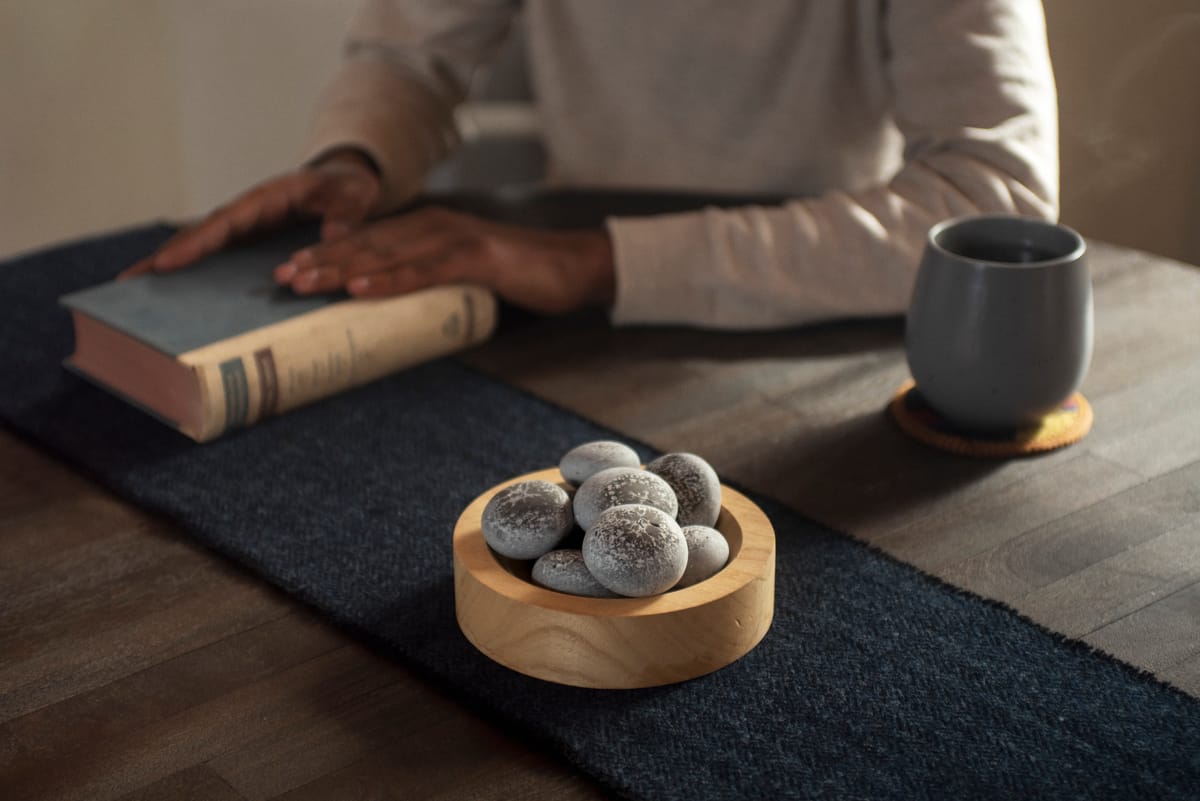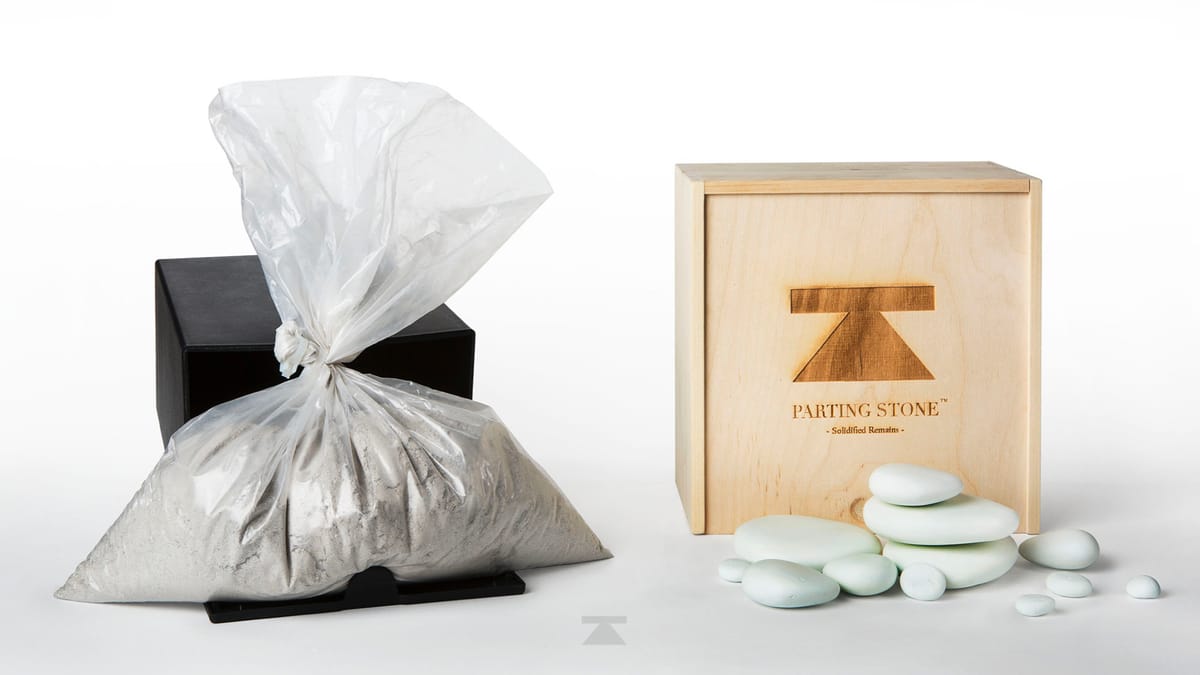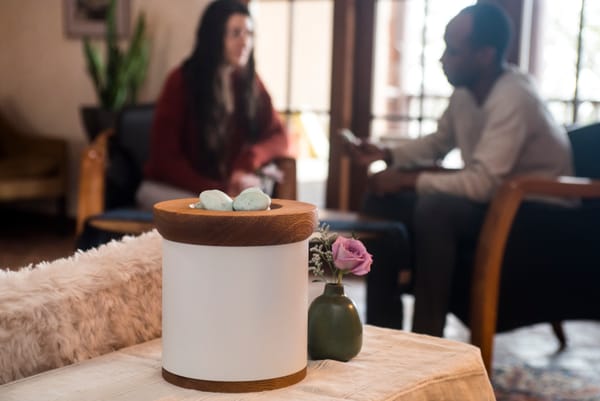Traditional vs Modern Memorial Options: What's Changed
From urns and burials to solidified remains and modern keepsakes, see how memorial options have evolved—helping families find the balance between tradition and innovation.

When Sarah's grandmother passed away, the family faced a decision their ancestors never had to make. Should they honor Grandma Rose with a traditional burial like her parents and grandparents before her, or explore one of the modern memorial options that better fit their scattered family across three states?
This question reflects a profound shift happening in how we remember and honor our loved ones. While traditional memorial practices have provided comfort and connection for generations, today's families increasingly seek options that match their values, lifestyles, and unique circumstances. The choice between traditional and modern memorial options isn't about right or wrong—it's about finding the most meaningful way to celebrate a life well-lived while supporting your family's healing journey.
If you're facing this decision, know that exploring your options is both natural and wise. Understanding what's available can help you make choices that honor your loved one while providing lasting comfort for everyone who misses them.
Reflections on love, loss, and the ways we carry them.
When I was growing up, I remember how my neighbor would visit her husband’s grave every Sunday after church. She’d bring fresh daisies from her garden and talk to him softly, telling him about the week. It wasn’t just a ritual of mourning; it was her way of staying connected. For many families, faith traditions offer that same comfort : a way to bridge the distance between heaven and earth through small, sacred acts of remembrance.
Today, families still long for that sense of closeness, but life looks different. Children move across states, faith traditions evolve, and loved ones often can’t visit a single resting place. That’s why many have begun to embrace solidified remains, which allow families to share the full amount of remains in solid form. It offers a new way to stay connected, giving each family member something tangible to hold, keep, or place in a spot that feels sacred to them.
Whether one chooses traditional burial or a modern process completed within 8 to 10 weeks, what truly matters is not the method, but the meaning. Every act of remembrance, old or new, carries the same quiet truth: love doesn’t fade when someone dies. It simply finds a new way to stay.
Cathy Sanchez Babao
Parting Stone Grief Coach
How Traditional Memorials Have Served Families for Generations
Traditional memorial practices have been the cornerstone of how we honor the departed for centuries. These time-tested approaches provide structure, community support, and tangible places for remembrance that have comforted countless families through their darkest hours.
Religious and Cultural Foundations
Traditional burials in cemeteries, marked with headstones and surrounded by family plots, stem from deep religious and cultural traditions. These practices created permanent spaces where families could visit, pray, and feel connected to their loved ones. The physical location provided a sense of continuity—a place where grandchildren could learn family history and where annual memorial services could bring everyone together.
Many faiths developed specific memorial traditions that honored both the deceased and community values. Christian burial practices emphasized resurrection hope, Jewish traditions focused on remembering and honoring the dead, and various cultural customs created meaningful rituals around memorial sites.
Traditional Cremation Memorial Options
As cremation became more accepted, traditional memorial options evolved to include urns, columbarium niches, and organized scattering ceremonies. These approaches maintained the dignity and reverence of burial traditions while offering families more flexibility and often lower costs.
However, traditional cremation created new challenges many families didn't anticipate. The "single urn dilemma" meant only one family member could keep their loved one's ashes, leaving others without a meaningful connection. Many families also experienced what grief counselors call "ashes anxiety"—discomfort with storing cremated remains in their homes, yet reluctance to inter them permanently.
Why Traditional Methods Remain Meaningful
Traditional memorial options continue serving families well for many important reasons. They provide established infrastructure through cemetery systems and funeral homes that families can trust during difficult times. Religious communities often have specific requirements or strong preferences for traditional approaches that provide spiritual comfort.
Cost considerations also matter. Traditional burial plots and basic urns are often perceived as more affordable upfront, though this doesn't always account for long-term cemetery fees or the emotional costs of limiting memorial access to distant family members.
Perhaps most importantly, traditional memorials honor generational expectations. Respecting the wishes of older family members or following practices that connect multiple generations can provide profound comfort during grief.

What's Driving the Shift to Modern Memorial Options
The funeral industry has witnessed dramatic changes over the past two decades, driven by demographic shifts, technological advances, and evolving family values. Understanding these changes helps explain why modern memorial options have emerged to meet new family needs.
Demographic and Social Changes
Cremation rates have skyrocketed from around 27% in 2000 to over 60% today, with projections reaching 82% by 2045 according to the National Funeral Directors Association. This shift reflects changing religious attitudes, environmental consciousness, and practical considerations about cost and mobility.
Modern families are more geographically scattered than ever before. Adult children often live hundreds or thousands of miles from their parents, making traditional cemetery visits challenging. When a loved one passes away, family members across different states, countries, or continents want meaningful ways to feel connected to the person they've lost.
Our understanding of healthy grief processing has also evolved. Research shows that having tangible connections to deceased loved ones can support healing, while isolation from memorial objects may complicate the grief journey. This has created demand for memorial options that can be shared among family members rather than kept in a single location.
Technology and Innovation Impact
Scientific advances have opened possibilities our grandparents couldn't have imagined. Memorial diamonds, created by extracting carbon from cremated remains, transform ashes into permanent gemstones. Solidification processes can turn ashes into touchable stones that feel more comfortable for families to handle and share.
Digital integration has also expanded memorial possibilities. QR codes on headstones can link to online memorial pages, virtual reality allows remote memorial visits, and social media platforms have become spaces for ongoing remembrance and story-sharing.
These innovations address practical challenges while honoring emotional needs. Families no longer have to choose between preserving their loved one's remains or ensuring multiple family members have meaningful keepsakes.
Generational Perspectives
Millennials and Generation X approach major life events differently than previous generations, emphasizing personalization and experience over rigid tradition. They're more likely to research options thoroughly, seek services that reflect their values, and prioritize emotional wellness in decision-making.
Environmental consciousness has also influenced memorial choices. Many families seek sustainable options like biodegradable urns with tree seeds, ocean reef memorials, or processes that minimize environmental impact while creating lasting tributes.
Exploring Today's Modern Memorial Alternatives
Modern memorial options offer families unprecedented flexibility in how they honor and remember loved ones. Each option serves different needs, budgets, and family dynamics, providing alternatives to traditional single-urn approaches.
Memorial Diamonds: Luxury Transformation
Memorial diamonds represent perhaps the most dramatic transformation possible with cremated remains. Companies extract carbon from ashes and subject it to high pressure and heat, creating genuine diamonds over 6-10 months.
These diamonds offer undeniable permanence and can be set into jewelry for daily wearing. The luxury appeal attracts families who want their loved one transformed into something precious and enduring. However, the process creates only a single diamond despite using multiple individuals' ashes, and costs typically range from $3,000 to $20,000 or more. The lengthy timeline can also be challenging for families who need more immediate comfort during early grief.
Solidified Remains: The Touchable Alternative
Solidified remains have emerged as an innovative solution that bridges traditional memorial values with modern family needs. This patented process transforms cremated ashes into smooth, stone-like forms that feel natural and comfortable to hold, addressing the "ashes anxiety" many families experience with traditional cremation.
The key advantage of solidification is shareability. Unlike processes that create single items, solidification produces multiple stones from one person's remains, allowing different family members to have meaningful keepsakes. At $2,495, this represents an accessible premium option—more affordable than memorial diamonds while offering similar transformation benefits.
The 6-8 week timeline provides a reasonable balance between immediate needs and quality processing. Over 10,000 families have chosen this option through partnerships with more than 600 funeral homes, demonstrating growing acceptance and trust in the process.
Solidified remains offer remarkable flexibility. The stones can be displayed in homes, carried as pocket remembrances, incorporated into garden memorials, or even scattered in meaningful locations. Some families choose to share stones with grandchildren as they grow older, creating lasting family connections across generations.
Memorial Jewelry and Keepsakes
Memorial jewelry allows families to keep small portions of ashes in pendants, rings, or bracelets. These pieces can be engraved with names, dates, or meaningful messages, creating personalized remembrances that integrate into daily life.
Pricing ranges from $100 for basic pieces to $2,000 for precious metal designs with gemstones. The main limitation is quantity—each piece holds only a small portion of ashes, so they work best as supplements to other memorial choices rather than complete solutions for multiple family members.
Eco-Friendly Memorial Options
Environmental consciousness has inspired memorial innovations that support ongoing life. Biodegradable urns containing tree seeds allow families to grow memorial forests, while underwater reef memorials contribute to ocean ecosystem restoration.
Green burial options return remains to earth naturally without embalming chemicals or permanent markers. These choices appeal to families who want their loved one's legacy to support environmental healing rather than consume resources.
Digital and Virtual Memorials
Technology has created entirely new categories of memorial options. Online platforms allow families to create digital legacy sites where memories, photos, and stories can be shared indefinitely. QR codes linked to memorial websites can be placed on traditional headstones, creating interactive experiences for visitors.
Social media integration lets ongoing remembrance happen naturally within existing family communication patterns. Virtual reality technology even enables remote memorial visits for family members who cannot travel to physical memorial sites.
Creative Artistic Memorials
Artistic memorial options incorporate ashes into blown glass sculptures, paintings, pottery, or custom artwork. These one-of-a-kind pieces reflect the deceased's personality and interests while creating beautiful memorial objects for display in homes.
Artists specializing in memorial work can create pieces ranging from $500 abstract sculptures to $5,000 elaborate installations, depending on complexity and materials used.
Memorial Options Comparison
| Option | Timeline | Cost Range | Shareability | Permanence | Best For |
|---|---|---|---|---|---|
| Traditional Urn | Immediate | $50-$500 | Single piece | High | Single location families |
| Memorial Diamonds | 6-10 months | $3,000+ | Single piece | Highest | Luxury preference |
| Solidified Remains | 6-8 weeks | $2,495 | Multiple stones | High | Scattered families |
| Memorial Jewelry | 2-4 weeks | $100-$2,000 | Limited portions | High | Personal wearing |
| Eco-Friendly Options | Varies | $200-$3,000 | Varies | Environmental | Sustainability focus |
How to Choose the Right Memorial Option for Your Family
Selecting between traditional and modern memorial options requires balancing multiple factors including family dynamics, budget considerations, religious requirements, and personal preferences. Rather than rushing this important decision, give yourself permission to explore options thoughtfully.
Understanding Your Family's Unique Needs
Start by considering how many family members want meaningful memorial keepsakes. If adult children live in different states while grandchildren may want remembrances as they grow older, options that create multiple pieces may serve your family better than single memorial items.
Budget planning should include both upfront costs and ongoing expenses. Traditional burial plots may require perpetual care fees, while memorial jewelry might need maintenance or insurance. Consider the total investment over time rather than just initial pricing.
Geographic factors significantly impact memorial choices. Families concentrated in one area might prefer traditional cemetery plots they can visit together, while scattered families may benefit from portable or shareable options that travel well.
Guiding Questions for Decision-Making
Ask yourself and your family these important questions:
"How many family members want a meaningful keepsake they can keep close?" This helps determine whether single-piece or shareable options work better for your situation.
"What timeline feels right for our grieving process?" Some families need immediate comfort, while others can wait for more elaborate memorial processes.
"What would our loved one have wanted?" Consider their personality, values, and any preferences they expressed about memorial arrangements.
"How important is shareability versus having one special memorial?" This fundamental question often guides families toward traditional or modern approaches.
The Importance of Professional Consultation
Funeral directors bring valuable expertise to memorial planning. They understand local regulations, can explain options clearly, and often have experience helping families navigate similar decisions. Don't hesitate to ask detailed questions about timelines, costs, and what to expect from different memorial processes.
Grief counselors can provide important perspectives on how different memorial choices might support or complicate your family's healing journey. They understand how tangible connections to deceased loved ones affect grief processing and can help you think through emotional considerations.
Family meetings, whether in-person or virtual, ensure everyone's voice gets heard in memorial planning. Consider including adult children, grandparents, and other close family members in discussions, while being mindful that the final decision rests with those legally responsible for arrangements.
Respecting Tradition While Embracing Innovation
One of the most delicate aspects of choosing modern memorial options involves navigating different religious, cultural, and generational perspectives within families. Success requires respectful communication and often creative compromise solutions.
Religious Perspectives on Modern Memorials
Different faith traditions have varying teachings about appropriate memorial practices. Catholic guidance has evolved to accept cremation while encouraging respectful treatment of remains. Many Protestant denominations support family choice in memorial decisions, focusing on the intentions behind selections rather than specific methods.
Jewish traditions generally emphasize earth burial, though different movements within Judaism have varying perspectives on cremation and memorial innovations. Islamic teachings typically require burial, though scholars continue discussing cremation in contexts where burial isn't possible.
When religious requirements conflict with family preferences, consult with spiritual advisors who understand both traditional teachings and contemporary realities. Many religious leaders can help families find approaches that honor faith requirements while meeting practical needs.
Cultural Sensitivity in Memorial Planning
Cultural traditions around death and remembrance vary significantly between different ethnic and regional backgrounds. Asian cultures often emphasize ancestral honor and may prefer memorial approaches that maintain family continuity. Hispanic and Latino traditions frequently center on family gatherings and celebrations of life that might influence memorial choice.
Native American perspectives on memorial practices vary greatly between different tribes and individuals' connections to traditional ways. Interfaith families may need to blend traditions from multiple backgrounds, requiring patient communication and mutual respect.
The key is understanding that cultural traditions developed to serve important community and spiritual functions. Modern memorial options that honor these underlying purposes while adapting to contemporary realities often find acceptance across cultural differences.
Building Bridges Between Generations
Generational differences in memorial preferences can create family tension during already difficult times. Older family members may feel that departing from traditional practices disrespects the deceased or abandons important family customs.
Successful bridge-building starts with listening carefully to different perspectives and acknowledging the legitimate concerns each generation raises. Older relatives often worry that modern approaches lack dignity or permanence, while younger family members may feel traditional options don't serve scattered modern families well.
Consider compromise solutions that incorporate elements of both traditional and modern approaches. For example, a family might choose traditional burial for the immediate deceased while creating solidified remains keepsakes for distant family members, or combine a traditional memorial service with modern sharing options.
Educational approaches can help family members understand new memorial possibilities without feeling pressured to abandon cherished traditions. Share information about modern options while emphasizing that the goal is honoring the deceased in ways that support the entire family's healing.
Finding Peace in Your Memorial Choice
Choosing how to memorialize a loved one represents one of the most personal decisions families make during grief. Whether you select traditional burial, modern alternatives, or creative combinations of both approaches, the most important consideration is finding options that honor your loved one while supporting your family's ongoing connection and healing.
Remember that there is no single "right" choice in memorial planning. Traditional approaches have provided comfort for generations and continue serving many families beautifully. Modern alternatives address new needs and circumstances that previous generations didn't face. The best memorial choice is the one that feels meaningful and appropriate for your unique family situation.
If you're feeling overwhelmed by memorial options, know that this reaction is completely normal. Grief affects decision-making abilities, and the wide range of available choices can feel overwhelming when you're already emotionally exhausted. Give yourself permission to take time with this decision, seek professional guidance, and involve trusted family members or friends in your thinking process.
Consider reaching out to grief counselors, funeral directors, or spiritual advisors who can provide perspective and support during memorial planning. These professionals understand the emotional complexity of these decisions and can help you think through options without pressure or judgment.
Many families find comfort in knowing that memorial choices can evolve over time. Initial memorial arrangements don't have to be permanent or complete. Families often add additional memorial elements as they process grief and as family circumstances change.
Moving Forward with Confidence
The evolution of memorial options reflects our growing understanding of grief, family dynamics, and the ways that meaningful connections to deceased loved ones support healing. Whether traditional or modern approaches serve your family best, the key is choosing options that provide lasting comfort and honor the memory of someone you love.
As you explore memorial possibilities, trust your instincts about what feels right for your family while remaining open to learning about new options that might serve your specific needs. The memorial planning process itself can become a meaningful way for families to process grief together and celebrate the life of someone who meant so much to all of you.
Take comfort in knowing that thoughtful memorial planning—whether traditional, modern, or a combination of both—creates lasting legacies that can provide comfort and connection for generations to come.
You're Not Alone in This Journey
Many families find that traditional ashes create more anxiety than comfort—whether it's difficulty with storage, challenges sharing among family members, or simply feeling uncomfortable with the form they're in. Over 10,000 families have found peace through Parting Stone's solidification process, which transforms ashes into smooth, natural stones that feel comforting to hold and easy to share.
When you're ready to explore options:
There's no timeline for grief, and there's no rush to make decisions. We're here to support you whenever you feel ready to take the next step.







